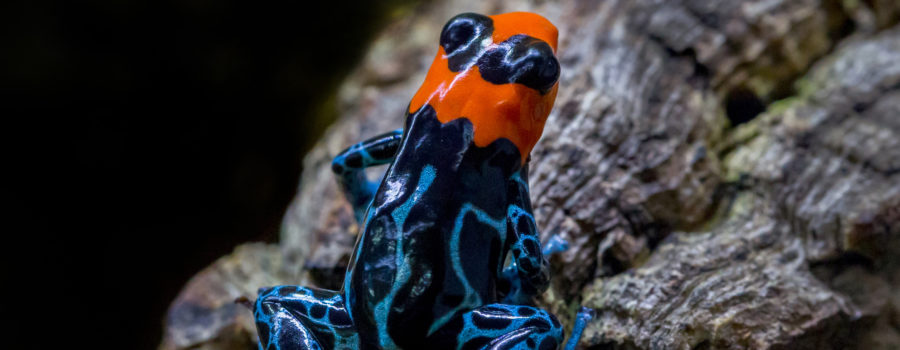Poison dart frogs are some of the most recognizable amphibians on the planet. Their bright colors and bold patterns serve as a warning to predators that their skin is toxic, an adaptation known as “aposematic coloration”. Dart frogs can vary in size, but the largest species only reach between one and two inches in length.
Diet: Like many amphibians, dart frogs are insectivores feeding on ants and other small insects found in their native tropical rainforests. The insects they consume are toxic, and eating them is what causes the frogs to be poisonous. The toxins from the insects are stored in glands on the frogs’ bodies, then secreted and spread over the skin.
In the Wild: Dart frogs have a variety of vocalizations that enable them to communicate during mating season, to mark territory, or to convey distress. Each type of frog is capable of producing a number of different sounds, and different species can be identified by their unique calls. Dart frogs have very few natural predators, including a species of snake that has developed a resistance to the dart frogs’ toxicity. Dart frogs earned their name because native indigenous people would coat their blow darts with the poison on the frog’s skin, although only three of the two-hundred and twenty species of dart frogs are known to have been used for this purpose.
Conservation issues/actions: Habitat loss is the most significant threat to all dart frogs. Deforestation due to illegal logging, agriculture, and human encroachment can drastically impact available territory since all of the dart frog species live in rainforest habitats. Another major threat to these frogs, as well as many other amphibians, is a potentially lethal pathogen known as the chytrid fungus. Some dart frogs are also taken from the wild for the international pet trade. Classification can vary by species, but many dart frogs are considered vulnerable or endangered, with a few that are critically endangered.
At the Zoo:
Unlike their wild cousins, the dart frogs here don’t eat any toxic insects so they don’t have stored poison in their bodies. Instead, they eat wingless fruit flies dusted with calcium powder for added nutrition. There are five species of frog in this habitat, three on one side and two on the other, and you’ll have to look closely in order to find them all! Despite their brilliant coloration, these little frogs are very good at finding places to hide.

